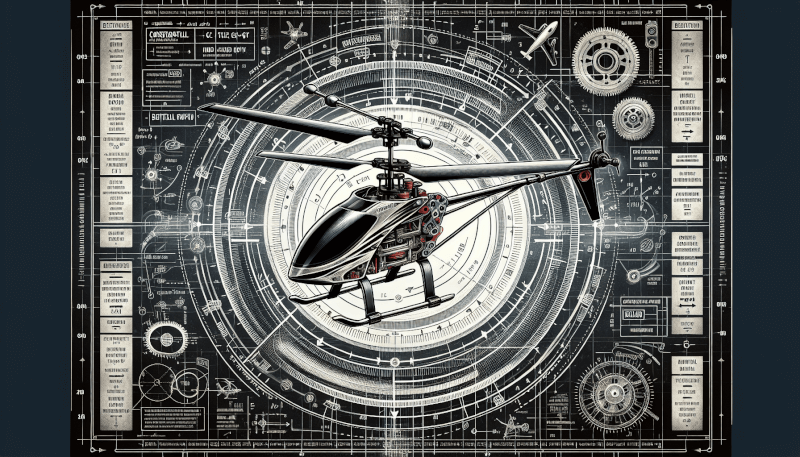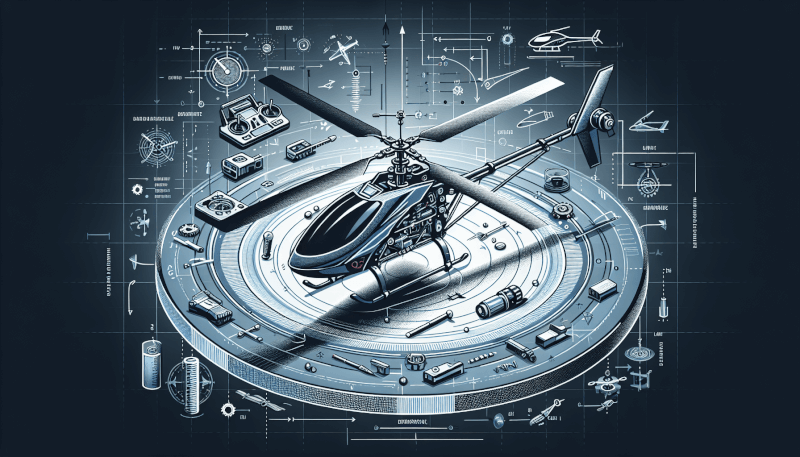Have you ever wondered why maintaining the right balance is crucial for operating RC helicopters? The key lies in understanding the importance of the center of gravity. This article will delve into the significance of center of gravity in RC helicopters and how it affects their stability and maneuverability. By grasping this fundamental concept, you’ll be able to enhance your flying skills and enjoy a smoother and more controlled flight experience. Let’s explore how center of gravity plays a vital role in the world of RC helicopters.
What is Center of Gravity (CG)?
Definition of center of gravity
The center of gravity (CG) is a crucial concept in the world of RC helicopters. It refers to the point at which the entire weight of the helicopter can be considered to be concentrated. It is the average location of all the individual weight components of the helicopter, including the fuselage, rotor blades, engine, battery, and other equipment. The CG is typically expressed as a distance from a specific reference point on the helicopter, such as the main rotor shaft or the leading edge of the main rotor blade.
Importance of center of gravity in RC helicopters
The center of gravity plays a vital role in the flight characteristics and stability of RC helicopters. By maintaining the correct CG position, you can ensure that the helicopter behaves predictably and flies smoothly. A properly balanced CG helps in achieving and maintaining stable flight, enhances maneuverability, and improves control responsiveness. On the other hand, an incorrect CG can lead to unstable flight, decreased control, and increased risk of accidents. Understanding and managing the CG of your RC helicopter is, therefore, of paramount importance for safe and enjoyable flying experiences.
Factors Affecting Center of Gravity
Weight distribution
The weight distribution of the various components in your RC helicopter has a direct impact on its center of gravity. Each component, such as the main rotor head, the tail rotor, the battery, and the electronics, contributes to the overall weight and distribution of the helicopter. Properly distributing the weight is essential to achieve the desired CG position. It is important to ensure that the weight is evenly distributed between the various components to maintain stability and control during flight.
Battery placement
The placement of the battery pack in an RC helicopter can significantly affect its center of gravity. The battery is usually one of the heaviest components, and its location can have a significant impact on the overall weight distribution. Placing the battery too far forward can shift the CG forward, while placing it too far back can shift the CG rearward. It is crucial to find the optimal position for the battery to maintain the desired CG position and ensure stable flight characteristics.
Rotor head design
The design of the rotor head also plays a role in the center of gravity of an RC helicopter. The rotor head consists of the main rotor blades, the swashplate, and various linkages. Different rotor head designs can have different CG positions, depending on factors such as the location of the swashplate and the weight distribution of the rotor blades. It is important to consider the CG position when choosing or modifying the rotor head design to ensure that it aligns with the desired CG location for optimal flight performance.
Size and shape of the helicopter
The size and shape of the helicopter can also affect its center of gravity. Larger helicopters tend to have a higher CG position due to the distribution of weight across a larger area. The shape of the helicopter, including the fuselage design, can also impact the CG position. It is essential to consider the size and shape of the helicopter when determining the optimal CG location and making any modifications or upgrades.
Modifications and upgrades
Any modifications or upgrades made to an RC helicopter can potentially affect its center of gravity. Adding new components or replacing existing ones can change the weight distribution and, consequently, the CG position. It is crucial to be mindful of these changes and adjust the CG accordingly to maintain stable flight characteristics. When making modifications or upgrades, it is recommended to consult the manufacturer’s recommendations or seek expert advice to ensure the correct CG position.

Effects of Incorrect Center of Gravity
Unstable flight
One of the most significant effects of an incorrect center of gravity in an RC helicopter is unstable flight. If the CG is too far forward or too far back, the helicopter may exhibit unpredictable and erratic behavior during flight. It can become difficult to maintain control and keep the helicopter stable. This instability can lead to difficulties in performing maneuvers and increase the risk of accidents.
Control responsiveness
The center of gravity also plays a crucial role in the control responsiveness of an RC helicopter. With the correct CG position, the helicopter will respond promptly and accurately to control inputs. However, an incorrect CG can lead to decreased control responsiveness, making it harder to maneuver the helicopter as desired. This can impact the pilot’s ability to perform precise movements and execute certain maneuvers.
Aerodynamic issues
The aerodynamics of an RC helicopter are directly influenced by the center of gravity. When the CG is properly positioned, the helicopter can maintain an optimal balance between lift and drag, allowing for efficient and stable flight. However, an incorrect CG can disrupt this balance, leading to aerodynamic issues. These issues can manifest as increased drag, decreased lift, or even abnormal flight characteristics such as excessive pitching or rolling.
Increased risk of accidents
An incorrect center of gravity can significantly increase the risk of accidents while flying an RC helicopter. Unstable flight, decreased control responsiveness, and aerodynamic issues can all contribute to accidents, including collisions, crashes, and loss of control. Maintaining the correct CG position is crucial for ensuring the safety of both the pilot and the helicopter itself.
Determining the Center of Gravity
Using a CG calculator
There are various methods and tools available to determine the center of gravity of an RC helicopter. One such tool is a CG calculator, which can be found online or as a smartphone application. A CG calculator requires you to input the relevant information, such as the weight distribution and the dimensions of the helicopter, and it calculates the CG position for you. This can be a quick and convenient method, especially for beginners or when working with complex helicopter designs.
Manual balancing method
The manual balancing method involves physically balancing the helicopter to determine its center of gravity. This method requires a balancing stand or a similar device where the helicopter can be securely mounted. By adjusting the position of the helicopter on the stand and observing how it balances, you can determine the CG position. This method allows for a more hands-on approach and can be effective, especially for experienced pilots or when dealing with unique helicopter designs.
Experimentation and adjustments
Determining the center of gravity may require some experimentation and adjustments. It is often a process of trial and error, where you make small changes to the weight distribution or the CG position and observe how it affects the helicopter’s flight characteristics. By carefully documenting your changes and the corresponding flight performance, you can gradually refine the CG position until you achieve the desired stability and control. Remember to make incremental adjustments and test each change before proceeding to the next to avoid making drastic and potentially destabilizing modifications.

Balancing Your RC Helicopter
Step-by-step process
Balancing an RC helicopter involves several steps to ensure the correct CG position and achieve optimal flight performance. Here is a step-by-step process to help you balance your helicopter:
Prepare your helicopter: Ensure that your helicopter is in a stable condition and free from any external factors that can affect its balance, such as loose components or unsecured equipment.
Determine the reference point: Identify the reference point on your helicopter, such as the main rotor shaft or the leading edge of the main rotor blade, from which you will measure the CG position.
Collect the necessary information: Gather the necessary information about your helicopter, such as the weight distribution of various components and the recommended CG position provided by the manufacturer.
Calculate or estimate the initial CG position: Use a CG calculator or refer to the manufacturer’s recommendations to estimate the initial CG position. This will serve as a starting point for further adjustments.
Perform a manual balance: Place your helicopter on a balancing stand or a similar device and observe how it balances. Make adjustments to the weight distribution or the CG position as necessary to achieve a level and stable balance.
Conduct flight tests: Take your helicopter for test flights to assess its stability and control responsiveness. Pay attention to any abnormal behavior or difficulties in maneuvering. Make notes of any changes or adjustments needed.
Refine the CG position: Based on the flight test results, make incremental adjustments to the weight distribution or the CG position to achieve the desired flight characteristics. Repeat the flight tests after each adjustment to assess the impact.
Repeat the process if necessary: If the helicopter does not exhibit the desired stability or control despite multiple adjustments, you may need to repeat the balancing process, considering factors such as modifications, upgrades, or changes in flight style.
Tools and equipment needed
To balance your RC helicopter effectively, you may need the following tools and equipment:
- Balancing stand or similar device: Provides a stable platform to mount and balance the helicopter.
- Digital scale: Allows you to measure the weight of individual components.
- CG calculator or smartphone application: Helps in estimating the initial CG position based on the collected information.
- Small weights or adhesive putty: Can be used to make small adjustments to the weight distribution if needed.
Tips and tricks for achieving balance
Achieving balance in your RC helicopter can be a nuanced process that requires attention to detail and patience. Here are some tips and tricks to help you achieve balance:
Accurate measurement: Ensure that your measurements of weight distribution and dimensions are as accurate as possible. Small errors in measurements can lead to significant discrepancies in the calculated CG position.
Record-keeping: Maintain a record of your adjustments and the flight performance after each change. This allows you to track your progress and revert to previous settings if needed.
Incremental adjustments: Make small and incremental adjustments to the weight distribution or the CG position. This allows you to observe the impact of each change and avoid making drastic modifications that can destabilize the helicopter.
Seek guidance: If you are new to balancing RC helicopters or facing challenges in achieving the desired balance, seek guidance from experienced pilots or consult the manufacturer’s guidelines. Their expertise can provide valuable insights and assist you in finding the optimal CG position.
Importance of Proper Center of Gravity
Enhanced stability
Maintaining a proper center of gravity is crucial for ensuring enhanced stability in an RC helicopter. By achieving the correct CG position, you can minimize unwanted movements and fluctuations during flight. This stability allows for more precise control inputs and a smoother flying experience, enhancing your overall enjoyment of flying your RC helicopter.
Improved flight performance
Proper center of gravity directly affects the flight performance of an RC helicopter. With the correct CG position, the helicopter can achieve better lift-to-drag ratios, allowing for more efficient flight. It also enables the helicopter to respond more accurately to control inputs, facilitating precise maneuvers and aerobatic flying. Furthermore, a well-balanced CG reduces the chances of unwanted oscillations and vibrations, resulting in a smoother and more enjoyable flight experience.
Better control and maneuverability
The center of gravity has a significant impact on the control and maneuverability of an RC helicopter. By maintaining the correct CG position, you can ensure that the helicopter responds predictably and promptly to control inputs. This allows for more precise and controlled movements, whether you are performing basic flight maneuvers or engaging in more advanced aerobatics. A properly balanced CG improves the pilot’s ability to execute maneuvers with confidence and precision.
Reduced chances of crashes
A properly balanced center of gravity significantly reduces the chances of crashes while flying an RC helicopter. An incorrect CG can lead to unstable flight characteristics, decreased control responsiveness, and aerodynamic issues, all of which can contribute to accidents. By ensuring that your helicopter is properly balanced, you minimize these risks and create a safer flying environment for both yourself and those around you.

Center of Gravity and Aerobatic Flying
Effects of CG on different maneuvers
The center of gravity plays a crucial role in the performance of various aerobatic maneuvers in RC helicopters. Different maneuvers require specific CG positions to achieve the desired flight characteristics. For example, for more aggressive and fast-paced maneuvers, a slightly forward CG position may be preferred to enhance stability and control responsiveness. On the other hand, for precise and smooth maneuvers, a slightly rearward CG position may provide better maneuverability and agility. It is essential to understand how the CG position can influence each maneuver and adjust it accordingly to optimize the helicopter’s performance.
Adjusting CG for specific flight styles
Different flight styles, such as sport flying, 3D aerobatics, and scale flying, may require different center of gravity positions. Each flight style has its own set of requirements and preferences when it comes to CG positioning. For example, sport flying may generally benefit from a more neutral CG position that provides a balance between stability and maneuverability. On the other hand, 3D aerobatics may favor a slightly forward CG position to enhance stability during aggressive maneuvers. Scale flying often aims to replicate the flight characteristics of real helicopters, necessitating a CG position specific to the scale model being flown. It is important to understand the flight style you prefer and adjust the CG position accordingly to optimize your helicopter’s performance.
Modifying CG for Special Situations
Changing CG for different payloads
In certain situations, you may need to modify the center of gravity of your RC helicopter to accommodate different payloads. For example, if you are carrying a camera or other additional equipment during aerial photography or videography, the additional weight can affect the CG position. It is crucial to consider the weight and distribution of the payload and adjust the CG position accordingly to maintain stability and control during flight. Consult the manufacturer’s guidelines or seek expert advice when modifying the CG for special payloads to ensure the safety and optimal performance of your helicopter.
Effects of wind conditions on CG
Wind conditions can also have an impact on the center of gravity of an RC helicopter. Strong winds can create additional forces and torques on the helicopter, affecting its balance and stability. In such situations, it may be necessary to adjust the CG position to counteract these external forces. By shifting the CG slightly, you can enhance the helicopter’s stability and improve its ability to handle windy conditions. It is important to be aware of the prevailing wind conditions and make the necessary adjustments to the CG position when flying in windy environments.
CG considerations for FPV flying
First-person view (FPV) flying, where you use a video feed from the helicopter’s onboard camera to navigate and control the helicopter, introduces additional considerations for the center of gravity. The placement of FPV equipment, such as the camera and video transmitter, can affect the CG position. It is important to carefully consider the weight and distribution of the FPV equipment and adjust the CG accordingly. A well-balanced CG is essential for stable and smooth FPV flights, ensuring optimal video quality and control responsiveness.

Safety Precautions when Adjusting CG
Securely fastening components
When adjusting the center of gravity of an RC helicopter, it is essential to ensure that all components are securely fastened. Loose components can not only affect the CG position but also pose safety hazards during flight. Double-check that all screws, bolts, and fittings are tight and properly secured. This includes components such as the battery, rotor head, and electronics. Regularly inspect your helicopter for any signs of wear or damage that may affect component security and CG stability.
Testing in controlled environments
When making adjustments to the center of gravity, it is important to test your helicopter in controlled environments. Choose open areas or designated flying sites that provide ample space and minimal obstacles. This allows you to assess the impact of the CG adjustments without the risk of colliding with objects or endangering bystanders. Avoid testing in crowded areas or areas with restricted airspace. Always follow local regulations and guidelines to ensure safe and responsible flying practices.
Seeking expert advice when necessary
If you are unsure about adjusting the center of gravity of your RC helicopter or facing challenges in achieving the desired balance, do not hesitate to seek expert advice. Experienced pilots and RC helicopter enthusiasts can provide valuable insights and guidance based on their own experiences. They can help you understand the nuances of CG adjustments and offer recommendations for your specific helicopter model or flight style. Reach out to local RC hobbyist groups, online forums, or professional instructors for assistance when needed.
Conclusion
In conclusion, understanding the importance of the center of gravity in RC helicopters is essential for safe and enjoyable flying experiences. Maintaining the correct CG position contributes to enhanced stability, improved flight performance, better control and maneuverability, and reduced chances of accidents. Factors such as weight distribution, battery placement, rotor head design, size and shape of the helicopter, and modifications or upgrades can all influence the CG position. Determining the center of gravity requires careful measurements, experimentation, and adjustments. Balancing your RC helicopter involves a step-by-step process, utilizing tools and equipment such as balancing stands, digital scales, CG calculators, and small weights. Always prioritize safety precautions, securely fasten components, and test adjustments in controlled environments. Seek expert advice when necessary to ensure optimal CG positioning and enjoy the full potential of your RC helicopter.



